Compact Laser Modules with USB Connector

- 405 nm, 520 nm, or 635 nm Typical Center Wavelength
- Collimated Output
- Ø11 mm Compact, Electrically Isolated Housing
- Plug-and-Play, USB-Powered Operation
PL201
520 nm, 0.9 mW Output Power
Sample beam profile of the PL202 USB laser module, measured using our BC106N-VIS CCD beam profiler at a distance of 5 m.
USB Connector
Module Engraved with Logo and Item #
Color at End of Module Corresponds to Laser's Spectral Color
Highly-Attenuating Electrical Filter Protects Against Power Supply Noise

Please Wait

Click to Enlarge
PL201 Laser Module Held in a KAD11NT Unthreaded Kinematic Adapter and Mounted into an FMP1 Fixed Optic Mount

Click to Enlarge
USB Laser Module Held in an AD11F SM1-Threaded Adapter and Mounted into a KM100T Threaded Kinematic Mount


Click to Enlarge
USB Housing Features
Features
- 405 nm, 520 nm, or 635 nm Typical Center Wavelength
- 0.9 mW Typical Output Power
- Collimated Output
- Ø11 mm Compact, Electrically Isolated Housing
- Constant Power Mode Operation Using Built-In Photodiode Feedback
- USB Type-A Plug-and-Play Operation
- Mounting Accessories Available
- Compatible with DS5 Power Supply (Sold Separately)
Thorlabs' USB-equipped laser modules feature a typical output power of 0.9 mW (laser safety Class 2) at 405 nm, 520 nm, or 635 nm typical center wavelengths. The collimated output has a Ø3 mm round beam profile at 50 mm from the housing. These modules offer single-spatial-mode output in a compact, electrically isolated cylindrical housing and are ideal for use as alignment lasers in optical systems. The lasers are driven in constant-power mode, with feedback from an internal photodiode used to maintain the optical output power. As these diodes are not thermally stabilized, their optical output power may fluctuate slightly during operation.
The USB Type-A connector on each laser module features a built-in, highly attenuating electrical filter to reduce noise for a more stable laser output. Also featured on the connector are a status LED, on/off switch, and laser warning information. Unlike our phono-jack-equipped laser modules and laser modules with bare wire leads, no adapters or extra connectors are needed to operate these lasers.
We recommend powering these lasers with our DS5 5 VDC power supply, which is sold separately below.
Mounting Options
The Ø11 mm housing is compatible with our line of optomechanical components through the use of various mounting adapters, as shown in the images to the right. Depending on the adapter chosen, these laser modules can be directly mounted into either internally SM1-threaded (1.035"-40) components or mechanics with a Ø1" bore. Further details on each adapter and its compatibility with our line of optomechanics can be found below.
Thorlabs also offers a Mini-Series kinematic mount for Ø11 mm laser diode modules (available below). This kinematic mount is among our smallest kinematic mounts available and features 4-40 (M3) taps for mounting onto our Ø6 mm Mini-Series Posts.
Laser Safety and Classification
Safe practices and proper usage of safety equipment should be taken into consideration when operating lasers. The eye is susceptible to injury, even from very low levels of laser light. Thorlabs offers a range of laser safety accessories that can be used to reduce the risk of accidents or injuries. Laser emission in the visible and near infrared spectral ranges has the greatest potential for retinal injury, as the cornea and lens are transparent to those wavelengths, and the lens can focus the laser energy onto the retina.
Safe Practices and Light Safety Accessories
- Thorlabs recommends the use of safety eyewear whenever working with laser beams with non-negligible powers (i.e., > Class 1) since metallic tools such as screwdrivers can accidentally redirect a beam.
- Laser goggles designed for specific wavelengths should be clearly available near laser setups to protect the wearer from unintentional laser reflections.
- Goggles are marked with the wavelength range over which protection is afforded and the minimum optical density within that range.
- Laser Safety Curtains and Laser Safety Fabric shield other parts of the lab from high energy lasers.
- Blackout Materials can prevent direct or reflected light from leaving the experimental setup area.
- Thorlabs' Enclosure Systems can be used to contain optical setups to isolate or minimize laser hazards.
- A fiber-pigtailed laser should always be turned off before connecting it to or disconnecting it from another fiber, especially when the laser is at power levels above 10 mW.
- All beams should be terminated at the edge of the table, and laboratory doors should be closed whenever a laser is in use.
- Do not place laser beams at eye level.
- Carry out experiments on an optical table such that all laser beams travel horizontally.
- Remove unnecessary reflective items such as reflective jewelry (e.g., rings, watches, etc.) while working near the beam path.
- Be aware that lenses and other optical devices may reflect a portion of the incident beam from the front or rear surface.
- Operate a laser at the minimum power necessary for any operation.
- If possible, reduce the output power of a laser during alignment procedures.
- Use beam shutters and filters to reduce the beam power.
- Post appropriate warning signs or labels near laser setups or rooms.
- Use a laser sign with a lightbox if operating Class 3R or 4 lasers (i.e., lasers requiring the use of a safety interlock).
- Do not use Laser Viewing Cards in place of a proper Beam Trap.
Laser Classification
Lasers are categorized into different classes according to their ability to cause eye and other damage. The International Electrotechnical Commission (IEC) is a global organization that prepares and publishes international standards for all electrical, electronic, and related technologies. The IEC document 60825-1 outlines the safety of laser products. A description of each class of laser is given below:
| Class | Description | Warning Label |
|---|---|---|
| 1 | This class of laser is safe under all conditions of normal use, including use with optical instruments for intrabeam viewing. Lasers in this class do not emit radiation at levels that may cause injury during normal operation, and therefore the maximum permissible exposure (MPE) cannot be exceeded. Class 1 lasers can also include enclosed, high-power lasers where exposure to the radiation is not possible without opening or shutting down the laser. |  |
| 1M | Class 1M lasers are safe except when used in conjunction with optical components such as telescopes and microscopes. Lasers belonging to this class emit large-diameter or divergent beams, and the MPE cannot normally be exceeded unless focusing or imaging optics are used to narrow the beam. However, if the beam is refocused, the hazard may be increased and the class may be changed accordingly. |  |
| 2 | Class 2 lasers, which are limited to 1 mW of visible continuous-wave radiation, are safe because the blink reflex will limit the exposure in the eye to 0.25 seconds. This category only applies to visible radiation (400 - 700 nm). |  |
| 2M | Because of the blink reflex, this class of laser is classified as safe as long as the beam is not viewed through optical instruments. This laser class also applies to larger-diameter or diverging laser beams. |  |
| 3R | Lasers in this class are considered safe as long as they are handled with restricted beam viewing. The MPE can be exceeded with this class of laser, however, this presents a low risk level to injury. Visible, continuous-wave lasers are limited to 5 mW of output power in this class. |  |
| 3B | Class 3B lasers are hazardous to the eye if exposed directly. However, diffuse reflections are not harmful. Safe handling of devices in this class includes wearing protective eyewear where direct viewing of the laser beam may occur. In addition, laser safety signs lightboxes should be used with lasers that require a safety interlock so that the laser cannot be used without the safety light turning on. Class-3B lasers must be equipped with a key switch and a safety interlock. |  |
| 4 | This class of laser may cause damage to the skin, and also to the eye, even from the viewing of diffuse reflections. These hazards may also apply to indirect or non-specular reflections of the beam, even from apparently matte surfaces. Great care must be taken when handling these lasers. They also represent a fire risk, because they may ignite combustible material. Class 4 lasers must be equipped with a key switch and a safety interlock. |  |
| All class 2 lasers (and higher) must display, in addition to the corresponding sign above, this triangular warning sign |  |
|
| Posted Comments: | |
David G
(posted 2020-09-10 05:46:15.6) Is there any reason why these USB lasers could not be used with the CPS1 Battery pack (that's only advertised for use with the CPS lasers)? MKiess
(posted 2020-09-10 10:46:48.0) Thank you very much for your inquiry. You can also power the compact laser modules with USB connector with the CPS1 battery pack. Nazim Bharmal
(posted 2020-06-29 09:33:47.173) It would be useful to know if the USB data-lines are connected or does the diode controller just draw power from the USB socket?
Also, if the data-pins are connected then is it possible to control the diode from a computer e.g. switch it on and off remotely? wskopalik
(posted 2020-07-02 04:40:31.0) This is a response from Wolfgang at Thorlabs. Thank you very much for your inquiry!
The USB connection is only used to supply power to the PL laser modules. The modules cannot be controlled via USB. You can only turn them on and off with the switch directly on the device.
I will contact you directly to provide further assistance. Lucile SANCHEZ
(posted 2020-01-15 16:21:47.503) Hello,
We were searching a device to align some beam paths that are coming onto the optical table through optical fibers (quite common). To do that we have a laser diode for alignment in which we can plug a fiber. This one is quite loose and we were searching some kind of similar device with different wavelengh. Your laser diode with USB is very nice, but there is not the possibility to plug a fiber through a APC connector mounted directly on the output of the diode. Could you make such a device? I am pretty sure that is worth making because a lot of people deal with optical diode nowadays.
Thanks a lot,
Have a nice day,
Lucile nreusch
(posted 2020-01-17 04:42:09.0) This is a response from Nicola at Thorlabs. Thank you very much for contacting us and for your suggestion. We do offer fiber-coupled benchtop devices as well as pigtailed laser diodes, but you are right about the fact they they cannot be driven via USB port. However, the fiber-coupled handheld laser source (HLS635, https://www.thorlabs.com/newgrouppage9.cfm?objectgroup_id=5929) might be interesting for your application. You would need to use an FC/PC-FC/APC hybrid patch cable to connect it to your fiber though. Vasily Goncharov
(posted 2019-12-15 17:45:52.223) Hi,
Thank you for this creative idea of a compact laser module that can be readily used for optical alignment. I believe it would be very useful to know whether the laser has enough of coherence length to be used with your shearing interferometer, SI050. In other words, will I see fringe pattern, if the laser beam from the PL201 goes through SI050?
Best Wishes,
Vasily Goncharov dpossin
(posted 2019-12-16 07:41:26.0) Hello Vasily,
Thank you for your feedback. For diode lasers it is not easy to put the coherence length into numbers. Reasons are that it depends on many parameters like reflection, temperature and current. Further there are also variations between batches. The coherence function of a comb of frequencies produces a beating pattern, so a single number is not sufficient to define the entire property of the laser. |

| Click Image for Full View |  |
 |
 |
| Item # | PL205 | PL201 | PL202 |
| Wavelength (Typical) | 405 nm | 520 nm | 635 nm |
| Output Power (Typical) | 0.90 mW | ||
| Laser Safety Class | Class 2 | ||
| Beam Shapea |
Round, Ø3 mm (Typical) at 5 cm | ||
| Typical Beam Profiles (Click Icon for Details) |
|||
| Housing Dimensions | Ø11.0 mm x 60.2 mm | ||
| Specifications | |||
| Alternative Laser with Bare Wire Leadsb | PL206 | PL203 | PL204 |

These adapters mount the laser diode housing into SM1 (1.035"-40) lens tubes, 30 mm cage systems, Ø1/2" posts, or Ø1/2" or Ø1" mounts. Please see the application photos in the Overview tab for examples.
The KAD11F and KAD11NT adapters provide ±6° of pitch and yaw adjustment. Two 80 TPI fine adjustment screws on the front plate of the adapter control the pitch and yaw position and can be turned using a 5/64" (2.0 mm) hex key.
| Click Image to Enlarge |  |
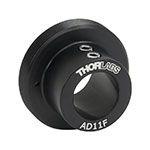 |
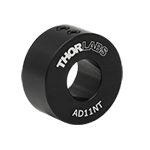 |
 |
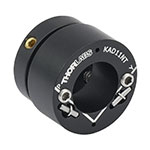 |
| Item # | AD11BA | AD11F | AD11NT | KAD11F | KAD11NT |
| Description | Unthreaded Adapter with a 1/2" Outer Diameter | Externally SM1-Threaded Adapter |
Unthreaded Adapter with a 1" Outer Diameter | Externally SM1-Threaded Kinematic Adapter with Pitch and Yaw Adjustment |
Unthreaded Kinematic Adapter with a 1" Outer Diameter and Pitch and Yaw Adjustment |
| Diode Module Housing Diameter | 11 mm | ||||


Click to Enlarge
PL201 USB Laser Module Mounted in a MK11F Mini-Series Kinematic Mount
- Securely Mount Ø11 mm Laser Diode Modules
- Angular Range: ±4°
- Compact Nominal Footprint: 0.79" x 0.52" (20.0 mm x 13.3 mm)
- Resolution: 13 mrad (0.77°) per Revolution via Two M2.5 x 0.20 Precision Adjusters
- 4-40 (M3) Mounting Holes Allow for Left- or Right-Handed Orientation
Thorlabs' Mini-Series Kinematic Mount for Cylindrical Components is our most compact solution for mounting the Ø11 mm laser diode modules sold above. This two-adjuster kinematic mount features a nominal 0.79" x 0.52" (20.0 mm x 13.2 mm) footprint, which is the same as our Mini-Series kinematic mirror mounts. Cylindrical components are secured at three points using a nylon-tipped locking screw and a double-bored mounting hole. Both the nylon-tipped setscrew and the two M2.5 x 0.20 adjuster screws accept a 0.050" (1.3 mm) hex key (not included).
For ease of adjustment, we recommend using the 0.050" hex key thumbscrews. We also offer a locking collar and spanner wrench for locking the adjuster screws in a desired position or for creating a hard stop.


Click for Details
Region-Specific Adapters for DS5
- 5 VDC Regulated Power Supply
- USB Type-A Port
- Compatible with Our USB-Powered Laser Modules
The DS5 is a 5 V, 2 A regulated power supply with a USB Type-A female port. It can be used with any USB-compatible device that accepts a 5 VDC output, and is directly compatible with our USB-powered laser modules. A region-specific adapter plug is shipped with the DS5 power supply unit based on your location.

- Portable USB Battery Pack with 5 VDC and up to 2 A Output
- Compatible with CPS Laser Modules and USB-Powered Devices
- 10 000 mAh Capacity
Thorlabs offers the CPS1 Battery Pack for powering our CPS laser modules and other USB-powered devices. The CPS1 battery pack outputs 5 VDC at up to 2 A, and offers 10 000 mAh capacity. A fully charged CPS1 battery pack can power any CPS laser module for at least 36 hours of continuous operation. The pack includes a USB-to-Micro-USB cable for charging and a custom USB-to-Phono cable for powering the CPS laser module. To activate the battery, simply push the power button once. The pack may be charged using standard 5 V USB chargers for portable devices or using a computer USB port. While the battery pack is charging, it can still supply power to an attached laser module.
The CPS1 Battery Pack also includes an LED flashlight adjacent to the micro-USB port. The flashlight is activated and deactivated by holding the power for two seconds.
When connecting the CPS Diode Module, the module and adapter should be connected first. Then the adapter cable should be plugged into the isolated power supply to avoid a short circuit in the phono jack. Please note that the USB adapter included with this battery pack is not intended to be used with power supplies that are not current-limited or isolated from ground, such as some computers or laptops.
 Products Home
Products Home




























 Zoom
Zoom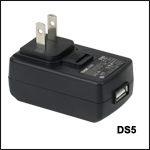
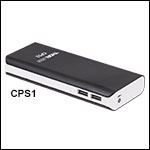
 Compact Laser Modules with USB
Compact Laser Modules with USB